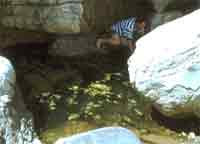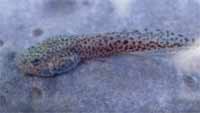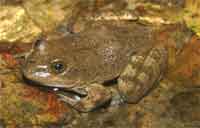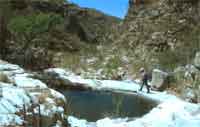 |
GETTING
A HEADSTART
The Tarahumara
frog disappeared from Arizona in the early 1980s. Read on to find
out how scientists plan to reintroduce this vanished frog into the wild—and
what you can do to help.

Stephen
Hale |
May
2000
U.S. biologists travel to the Sierra La Madera in northern
Sonora, Mexico, and collect part of an egg mass laid by a
Tarahumara frog. With appropriate permits, they take the egg mass
to Fish and Wildlife Service headquarters in Phoenix, Arizona.
|

Stephen
Hale |
May
2000
Eight days later between 850 and 900 eggs hatch.
|

Jim Rorabaugh
|
June
2000
The tadpoles begin life in a ten-gallon aquarium. About half
the water is replaced daily with tap water aged for 24 hours to
let the chlorine disperse. At first the tadpoles eat chopped spinach
and fish food. As they grow, their diet expands to include
sliced cucumbers and zucchini, boiled egg whites, filamentous algae,
and freeze-dried tubifex worms.
|

Jim Rorabaugh
|
July
2000
The tadpoles grow rapidly. Many are moved to foster
homes, including the Arizona-Sonora Desert Museum, San Bernardino
National Wildlife Refuge, Buenos Aires National Wildlife Refuge,
Coronado National Memorial, and Arizona State University.
|

Jim Rorabaugh
|
August
2000
The first frogs emerge at Buenos Aires refuge 86 days
after hatching. This is a surprise because biologists thought Tarahumara
tadpoles took at least a year to change into frogs. Perhaps warm
water and plenty of high-quality food stimulated their quick development.
Only some of the tadpoles metamorphose rapidly, though. Others grow
more slowly and aren’t expected to metamorphose until next spring
or summer. Perhaps some tadpoles are programmed to grow more rapidly
than others. Scientists have observed this adaptation in other frogs,
so it may serve to improve reproductive success in a variety of
environmental conditions. The young frogs vary in length from slightly
less than an inch to about two inches.
|
| |
October
2000
The young frogs held in aquariums are fed crickets and
mealworms, while those released in semi-wild enclosures forage
for themselves. Some of the outdoor frogs are now 2-1/4 inches long.
|

Cecil Schwalbe |
December
2000
About 350 frogs and tadpoles are still alive. Some of those
in outdoor enclosures have fallen victim to giant water bugs
(up to four inches long) like the one in the photo, which is devouring
a metamorphosed northern casque-headed frog. Because all these frogs
came from a single egg mass, biologists will need to collect more
egg masses from the wild to establish a healthy breeding population.
Even with these additions, the frogs will be bred selectively to
increase genetic diversity. Producing egg masses and tadpoles in
captivity will reduce the need to remove frogs from the wild.

|
THE
TARAHUMARA FROG NEEDS YOUR HELP!
The Tarahumara
Frog Conservation Team, a consortium of interested citizens, researchers,
and government wildlife and land managers, has developed a plan to
reintroduce the Tarahumara frog into at least two of its former homes
in Arizona—Big Casa Blanca Canyon in the Santa Rita Mountains and
Sycamore Canyon in the Pajarito Mountains. Once the Arizona Game and Fish
Commission approves the plan, the captive frogs will be released this
summer.
The Tarahumara
frog needs your help! Approval isn’t a sure thing. Some
people don’t want another rare species in their “backyard.” Others fear
that reintroduction might threaten livestock grazing, mining, and recreation,
even though these activities didn’t contribute to the frog’s disappearance.
If you
support the reintroduction, please write to the following officials
to urge prompt approval and implementation of the conservation plan:
W. Hays
Gilstrap
Chairman
Arizona Game and Fish Commission
2221 West Greenway Road
Phoenix, Arizona 85023-4399
Susan
Chilton (the reintroduction sites are in her district)
Arizona Game and Fish Commission
2221 West Greenway Road
Phoenix, Arizona 85023-4399
Duane
Shroufe
Director
Arizona Game and Fish Department
2221 West Greenway Road
Phoenix, Arizona 85023-4399

TARAHUMARA
FROG (Rana tarahumarae)

Stephen
Hale |
Description
Small, dark
spots on its body and dark crossbars on its legs distinguish this
drab green-brown, medium-size (2.5-4.5 inches from nose to rear)
frog. Because it lives in the water, its hind feet are extensively
webbed. Both males and females call—a low grunt that lasts about
half a second.
|

Stephen
Hale |
Distribution
Until the early 1980s, Tarahumara frogs ranged from the Sierra Madre
Occidental northwestern Mexico (southwestern Chihuahua, eastern
Sonora, and northern Sinaloa) into the Santa Rita and Atascosa-Parajarito
Mountains of southernmost Arizona. The last Tarahumara frog in Arizona
was spotted in 1983 in the Santa Ritas. Today they are most plentiful
in the mountains of eastern Sonora (see photo).
Habitat: Streams and deep plunge pools in pine-oak woodland,
thorn scrub, and tropical deciduous forest.
|
Diet
Tarahumara frogs feed on a wide variety of prey items, including fish,
juvenile mud turtles, snakes, beetles, moths, water bugs, scorpions, centipedes,
grasshoppers, mantids, wasps, spiders, crickets, caddis flies, and katydids.
In turn, Tarahumara frogs are probably eaten by ringtail cats, birds,
snakes (especially garter snakes), other frogs, rosy salamanders, fish,
and water bugs and other invertebrates.
Reproduction
Tarahumara frogs favor pools in steep canyon streams as breeding sites.
The greenish yellow, spotted tadpoles grow as long as 3.8 inches before
turning into frogs.
Status in Arizona
Last seen in the wild in May 1983.
Possible culprits in disappearance
from Arizona
Disease
Climate change (flooding, severe drought,
colder winter)
Introduced aquatic predators
Pollution (acid rain, heavy metal poisoning)

|





